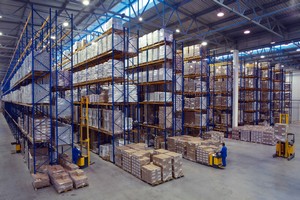Automated Guided Vehicles
Automated Guided Vehicles

Robotic forklifts doing your order-picking… driver-less pallet jacks taking orders to their collection points… faceless machines packing orders into vans…
Can you imagine your warehouse running itself?
It might sound like something from a bizarre science fiction movie, but having robots that help run warehouses is not actually that new a concept at all. In fact, the very first industrial robot (more commonly known as an Automated Guided Vehicle (AGV)), was invented in the 1950s by Barrett Electronics.
But what are AGVs, how are they used today, and what is the future of robotics in warehousing? This article aims to explore these three questions.
What Are AGVs?
An AGV is any vehicle designed to operate without the need for a driver – as the name suggests, it is an Automated Guided Vehicle.
The earliest AGVs were designed to tow objects behind them, using a wire in the floor for guidance. More recently, AGVs have been developed to handle more complex tasks using more advanced guiding technology.
Perhaps the most interesting part of a driver-less vehicle is working out how to tell it where to go. Some of the most common types of guiding technology used in modern AGVs are as follows:
Wire: Perhaps the most basic method of guiding a vehicle, this involves cutting a slot into the floor that marks out the vehicle’s intended route. A wire is run along the slot, and transmits radio signals to guide the vehicle.
Tape: Similar to the wire guiding technique, this involves marking out the vehicle’s intended path on the floor, but instead of physically carving a wired path out, colored or magnetic tape is used instead.
Laser: Laser target navigation involves mounting reflective tape to walls, which the vehicle can detect, using lasers, to establish its location and programmed path.
Gyroscopic: Using a central computer to program the intended path of vehicles, gyroscopic navigation involves installing transponders beneath the floor which transmit the instructions from the computers to tell the vehicles where they are and where to go.
Vision: Vision-guided AGVs require no installation of extra products on the premises, and instead rely on in-built video technology to build a working memory of the area and their intended routes, in order to successfully navigate the location.
Some AGVs can operate on auto-pilot, but also be switched into manual operating mode.
How are AGVs Used Today?
AGVs have advanced significantly since the early days of bulky tow tractors following a wire that runs along the floor, and companies are using these machines to automate even more complex tasks that would have previously required manual operation.
AGVs are used in several industries, including medical, automotive and even entertainment (such as theme parks).
In warehousing, AGVs are becoming available for most common operations – such as automatic forklifts for automating stock-picking, shelf-stacking, loading and more.
The main issue right now with AGVs, is any warehouse looking to bring these handy little helpers into their premises, will need a very hefty investment. Some early adopters are opting for rental rather than outright purchase, which is certainly more affordable – according to AGV Company NDCAutomotion, the cost of leasing one machine stands at around $5,400 per month, increasing to $36,500 per month for an automated 10-vehicle fleet complete with a small Warehouse Management solution. But although the monthly running costs is estimated to provide around 75% savings on labor costs, leasing a fleet of AGVs comes with its own caveats – companies will generally be tied into a long contract for several years, and at the end of it will not own any of the machines they have invested so much money into. (Source: http://www.ndcautomation.com/?page_id=12)
What is the Future of Robotics in Warehousing?
Even though totally robotic warehouses might yet be a long way away, there are a lot of predictions that suggest AGVs are going to become a very big thing in the warehouse industry in the fairly near future.
In fact, according to SC Digest (source: http://www.scdigest.com/assets/FirstThoughts/15-02-06.php), predictions currently estimate that as soon as 2018, we’ll see 5% of companies with complex picking operations, using self-navigating warehouse robots.
The same source states that although commercial adoption is expected to remain low the technology will continue to evolve rapidly, to the point where we may be seeing brand new automatic solutions to age-old manual problems, in as little as the next 5 years.
What Will Happen if Robotic Technology Becomes a ‘Thing’ in Warehouses?
If you operate a warehouse, then robotic technology taking over could be really positive – there would be a lower cost of manpower, and it would be easier for one person to oversee multiple tasks at once.
Perhaps the biggest concern though, will be the affordability of introducing ‘smart’ technology to help you run your warehouse – will your business be able to afford the initial investment in order to reap the long-term rewards?
We don’t know if the predictions above are right, or if 5% of warehouses really will be using robotic order pickers in just a few short years… but we’re definitely excited to see where the future of AGVs and robotic warehouse technology goes, so watch this space!
